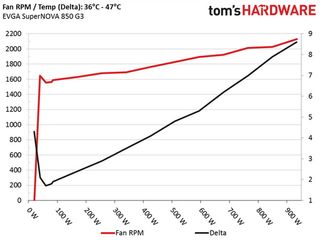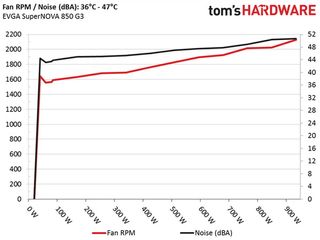EVGA SuperNOVA 850 G3 PSU Review
EVGA refreshed its popular G2 PSU family with the G3 one using Super Flower's Leadex II platform. The 850 G3 is the second strongest member in this line-up, offering high performance and a depth of just 15cm.
Why you can trust Tom's Hardware
Efficiency, Temperature, And Noise
Efficiency
Our efficiency testing procedure is detailed here.
Using results from the previous page, we plotted a chart showing the 850 G3's efficiency at low loads, and loads from 10 to 110 percent of its maximum-rated capacity.




This is one of the most efficient PSUs in the Gold-rated 850W category. Super Flower built a top-notch successor to the original Leadex Gold platform.
Efficiency At Low Loads
In the following tests, we measure the 850 G3's efficiency at loads significantly lower than 10 percent of its maximum capacity (the lowest load the 80 PLUS standard measures). The loads we dialed were 20, 40, 60, and 80W. This is important for representing when a PC is idle, with power-saving features turned on.
| Test # | 12V | 5V | 3.3V | 5VSB | DC/AC (Watts) | Efficiency | Fan Speed | Fan Noise | PF/AC Volts |
|---|---|---|---|---|---|---|---|---|---|
| 1 | 1.210A | 0.501A | 0.478A | 0.197A | 19.69 | 74.106% | 0 RPM | 0 dB(A) | 0.743 |
| 12.065V | 4.989V | 3.315V | 5.095V | 26.57 | 115.07V | ||||
| 2 | 2.445A | 1.000A | 0.996A | 0.390A | 39.79 | 78.830% | 1645 RPM | 44.4 dB(A) | 0.875 |
| 12.070V | 4.989V | 3.315V | 5.092V | 50.47 | 115.07V | ||||
| 3 | 3.678A | 1.496A | 1.507A | 5.086A | 59.86 | 83.104% | 1555 RPM | 43.2 dB(A) | 0.924 |
| 12.077V | 4.991V | 3.316V | 5.086V | 72.03 | 115.07V | ||||
| 4 | 4.901A | 2.004A | 1.990A | 0.786A | 79.77 | 85.165% | 1565 RPM | 43.5 dB(A) | 0.947 |
| 12.074V | 4.991V | 3.316V | 5.080V | 93.66 | 115.08V |
Under light loads, the 850 G3 achieves good efficiency. However, its passive mode is really brief, after which the fan spins at high speeds. During the second test, the fan spins more quickly than in the other two tests to quickly exhaust heat from the PSU's internals.
5VSB Efficiency
The ATX specification states that 5VSB standby supply efficiency should be as high as possible, recommending 50 percent or higher with 100mA of load, 60 percent or higher with 250mA of load, and 70 percent or higher with 1A or more of load.
We take four measurements: one each at 100, 250, and 1000mA, and one with the full load the 5VSB rail can handle.
| Test # | 5VSB | DC/AC (Watts) | Efficiency | PF/AC Volts |
|---|---|---|---|---|
| 1 | 0.101A | 0.515 | 66.796% | 0.057 |
| 5.098V | 0.771 | 115.11V | ||
| 2 | 0.251A | 1.279 | 74.145% | 0.120 |
| 5.094V | 1.725 | 115.11V | ||
| 3 | 1.002A | 5.087 | 78.322% | 0.308 |
| 5.077V | 6.495 | 115.11V | ||
| 4 | 3.002A | 15.073 | 76.876% | 0.442 |
| 5.021V | 19.607 | 115.10V |


The 5VSB regulation circuit needs a redesign to enable higher efficiency. It is a shame to see the 850 G3's 5VSB rail demonstrate mediocre performance when the PSU fares so well in the other disciplines we've looked at so far.
Power Consumption In Idle And Standby
In the table below, you'll find the power consumption and voltage values of all rails (except -12V) when the PSU is idle (powered on, but without any load on its rails), and the power consumption when the PSU is in standby mode (without any load, at 5VSB).
| Mode | 12V | 5V | 3.3V | 5VSB | Watts | PF/AC Volts |
|---|---|---|---|---|---|---|
| Idle | 12.063V | 4.989V | 3.316V | 5.103V | 8.346 | 0.432 |
| 115.1V | ||||||
| Standby | 0.142 | 0.011 | ||||
| 115.1V |


Standby power consumption is high with both voltage inputs.
Using230V input and registering close to 0.25W vampire power, the PSU was unable to achieve higher than 45% efficiency at 5VSB with 0.225W load, which is required by the ATX spec.
Fan RPM, Delta Temperature, And Output Noise
Our mixed noise testing is described in detail here.
The first chart below illustrates the cooling fan's speed (in RPM), and the delta between input and output temperature. The results were obtained at 36°C (96.8°F) to 47°C (116.6°F) ambient temperature.

The next chart shows the cooling fan's speed (again, in RPM) and output noise. We measured acoustics from one meter away, inside a small, custom-made anechoic chamber with internals completely covered in sound-proofing material (be quiet! Noise Absorber kit). Background noise inside the chamber was below 18 dB(A) during testing, and the results were obtained with the PSU operating at 36°C (96.8°F) to 47°C (116.6°F) ambient temperature.

The following graph illustrates the fan's output noise over the PSU's operating range. The same conditions of the above graph apply to our measurements, though the ambient temperature was between at 30°C (86°F) to 32°C (89.6°F).

As we've mentioned, EVGA's passive mode doesn't last for long. The fan profile is aggressive in general, and given the PSU's high efficiency, it could definitely be much more relaxed. Obviously EVGA wanted to stay on the safe side given its 10-year warranty.
Current page: Efficiency, Temperature, And Noise
Prev Page Load Regulation, Hold-Up Time, And Inrush Current Next Page Protection Features, EvaluatedStay on the Cutting Edge
Join the experts who read Tom's Hardware for the inside track on enthusiast PC tech news — and have for over 25 years. We'll send breaking news and in-depth reviews of CPUs, GPUs, AI, maker hardware and more straight to your inbox.
Aris Mpitziopoulos is a Contributing Editor at Tom's Hardware US, covering PSUs.
-
envy14tpe Made by Super Flower? Love the quality SF produces. Can't wait to buy my new Leadex II.Reply -
powernod For those looking for an "80+ Gold efficient PSU", probably they won't have to look elsewhere. LeadexII seems amazing platform!!Reply -
BugariaM Based on the information from EVGA siteReply
Such an aggressive fan curve is only made on 1000W and 850W units of the G3 series
550W, 650W and 750W - have a much smoother relaxed curve
I'm curious, what is the fan curve for the 850W unit when the ECO mode is off? It is possible that in this mode it will be much quieter at normal load... -
waylo Dangit. Just bought this yesterday, focusing on a quiet PSU, deciding on this over the G2 or P2 version. I know the quality will be there, but disappointed in the noise levels.Reply -
Virtual_Singularity Excellent, impressively thorough and professional review, as usual. Much appreciated.Reply -
Stone Cold Reply
So you are saying this PSU is miles better than the Seasonic prime?!19439055 said:Ahh, SuperFlower. I don't know why people buy anything else.